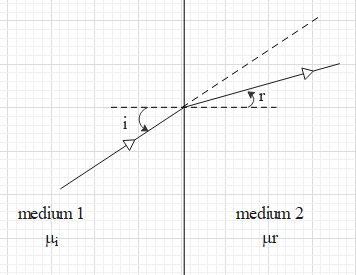
Write down Snell’s law of refraction and explain.
Answer
533.4k+ views
Hint: When a light ray passes from one medium into a different medium the light bends. This is called refraction. Snell’s law of refraction gives us the relation between the refractive indices of the two mediums and the angles of incidence and refraction.
Complete step by step answer:
Let us first understand what is meant by refraction of light. Refraction is the phenomenon of bending of a light ray when it passes from one medium into another medium, at the interface of the two mediums.
Light travels with a certain speed in a given medium. When light enters into a different medium, its speed changes. As a result, the ray of light appears to bend at the interface of the two mediums.
We understand the amount of bending of a light ray by Snell's law.
The Snell’s law states that ${{\mu }_{i}}\sin i={{\mu }_{r}}\sin r$.
Here, ${{\mu }_{i}}$ is the refractive of the medium in which the light ray is incident, ${{\mu }_{r}}$ is the refractive index of the medium in which the light ray enters after refraction. i and r are the angles of incidence and refraction as shown.

Refractive index of a medium is defined as the ratio of the speed of light in that medium to the speed of light in vacuum.
i and r are the angles that the incident ray and refracted ray make with the normal drawn at the interface, respectively.
Note: Note that when the light passes from a rarer medium into a denser medium, the angle of incidence is greater than the angle of refraction.
Whereas when the light passes from a denser medium into a rarer medium, the angle of incidence is lesser than the angle of refraction.
Complete step by step answer:
Let us first understand what is meant by refraction of light. Refraction is the phenomenon of bending of a light ray when it passes from one medium into another medium, at the interface of the two mediums.
Light travels with a certain speed in a given medium. When light enters into a different medium, its speed changes. As a result, the ray of light appears to bend at the interface of the two mediums.
We understand the amount of bending of a light ray by Snell's law.
The Snell’s law states that ${{\mu }_{i}}\sin i={{\mu }_{r}}\sin r$.
Here, ${{\mu }_{i}}$ is the refractive of the medium in which the light ray is incident, ${{\mu }_{r}}$ is the refractive index of the medium in which the light ray enters after refraction. i and r are the angles of incidence and refraction as shown.

Refractive index of a medium is defined as the ratio of the speed of light in that medium to the speed of light in vacuum.
i and r are the angles that the incident ray and refracted ray make with the normal drawn at the interface, respectively.
Note: Note that when the light passes from a rarer medium into a denser medium, the angle of incidence is greater than the angle of refraction.
Whereas when the light passes from a denser medium into a rarer medium, the angle of incidence is lesser than the angle of refraction.
Recently Updated Pages
Master Class 12 Business Studies: Engaging Questions & Answers for Success

Master Class 12 Biology: Engaging Questions & Answers for Success

Master Class 12 Physics: Engaging Questions & Answers for Success

Class 12 Question and Answer - Your Ultimate Solutions Guide

Master Class 12 English: Engaging Questions & Answers for Success

Master Class 12 Economics: Engaging Questions & Answers for Success

Trending doubts
Which are the Top 10 Largest Countries of the World?

What is transplantation in agriculture class 12 biology CBSE

Differentiate between homogeneous and heterogeneous class 12 chemistry CBSE

Why is the cell called the structural and functional class 12 biology CBSE

Hydrological cycle is controlled by A Grasslands B class 12 biology CBSE

Who discovered the cell and how class 12 biology CBSE




